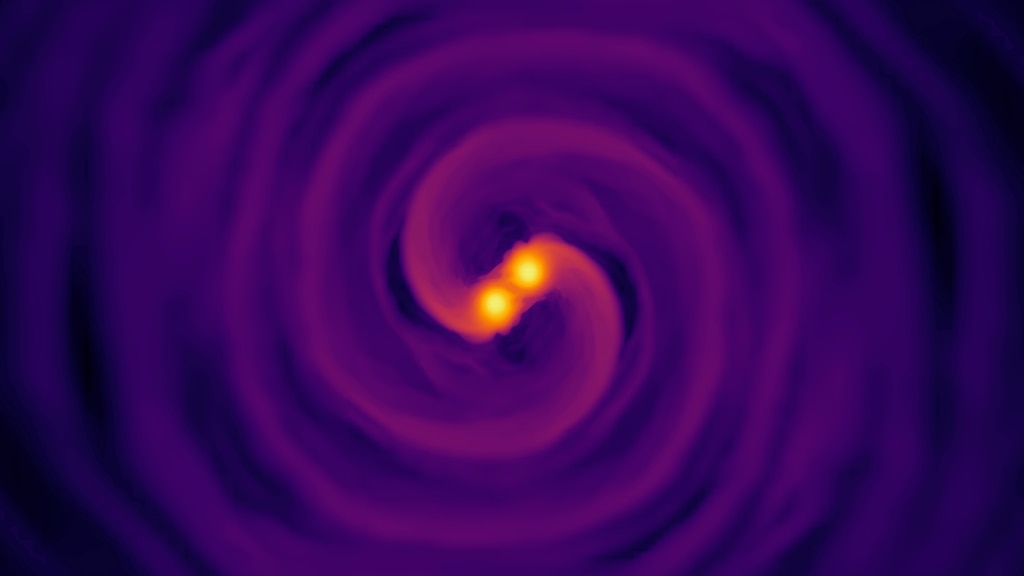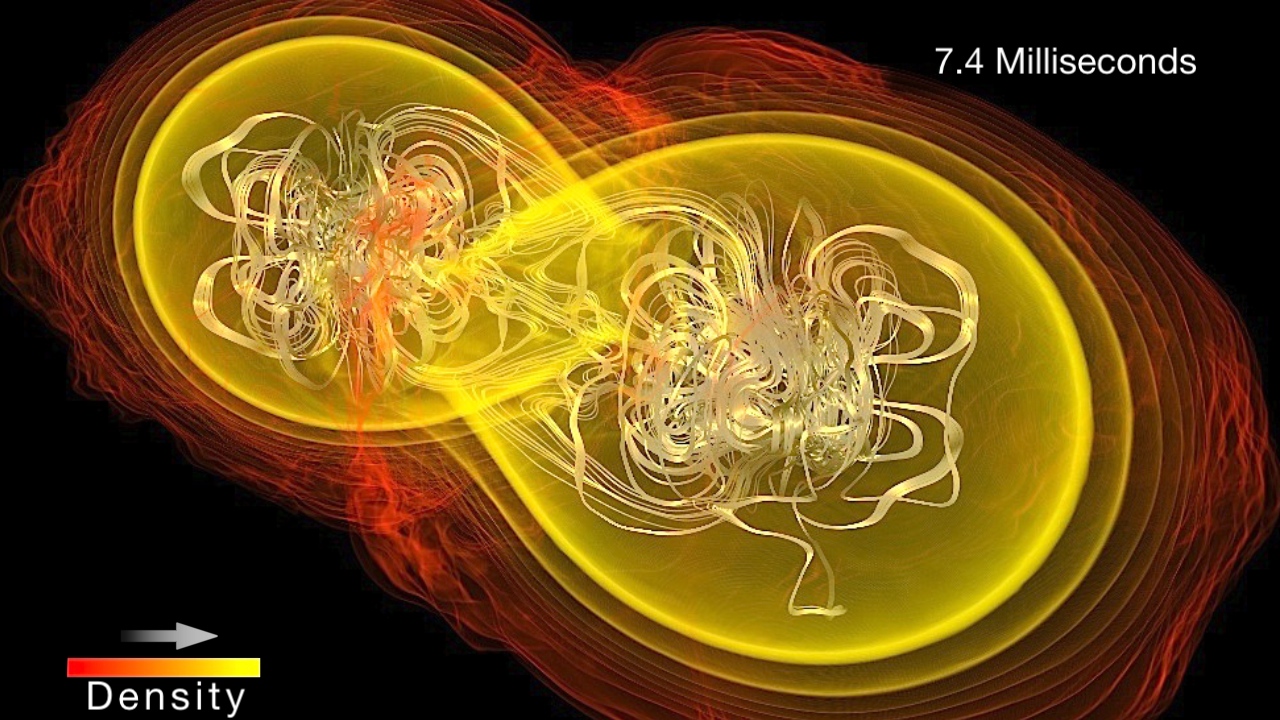Neutron Stars Rip Each Other Apart to Form Black Hole
This supercomputer simulation shows one of the most violent events in the universe: a pair of neutron stars colliding, merging and forming a black hole. A neutron star is the compressed core left behind when a star born with between eight and 30 times the sun's mass explodes as a supernova. Neutron stars pack about 1.5 times the mass of the sun — equivalent to about half a million Earths — into a ball just 12 miles (20 km) across.
As the simulation begins, we view an unequally matched pair of neutron stars weighing 1.4 and 1.7 solar masses. They are separated by only about 11 miles, slightly less distance than their own diameters. Redder colors show regions of progressively lower density.
As the stars spiral toward each other, intense tides begin to deform them, possibly cracking their crusts. Neutron stars possess incredible density, but their surfaces are comparatively thin, with densities about a million times greater than gold. Their interiors crush matter to a much greater degree densities rise by 100 million times in their centers. To begin to imagine such mind-boggling densities, consider that a cubic centimeter of neutron star matter outweighs Mount Everest.
By 7 milliseconds, tidal forces overwhelm and shatter the lesser star. Its superdense contents erupt into the system and curl a spiral arm of incredibly hot material. At 13 milliseconds, the more massive star has accumulated too much mass to support it against gravity and collapses, and a new black hole is born. The black hole's event horizon — its point of no return — is shown by the gray sphere. While most of the matter from both neutron stars will fall into the black hole, some of the less dense, faster moving matter manages to orbit around it, quickly forming a large and rapidly rotating torus. This torus extends for about 124 miles (200 km) and contains the equivalent of 1/5th the mass of our sun. The entire simulation covers only 20 milliseconds.
Scientists think neutron star mergers like this produce short gamma-ray bursts (GRBs). Short GRBs last less than two seconds yet unleash as much energy as all the stars in our galaxy produce over one year.
The rapidly fading afterglow of these explosions presents a challenge to astronomers. A key element in understanding GRBs is getting instruments on large ground-based telescopes to capture afterglows as soon as possible after the burst. The rapid notification and accurate positions provided by NASA's Swift mission creates a vibrant synergy with ground-based observatories that has led to dramatically improved understanding of GRBs, especially for short bursts.
Edited video with music of the 4k neutron star merger simulation.
Credit: NASA/AEI/ZIB/M. Koppitz and L. Rezzolla
Music: "Approaching Eclipse" from stock music site Killer TracksWatch this video on the NASA Goddard YouTube channel.
For complete transcript, click here.
Simulation frames and video at 4000x3200 resolution.
Credit: NASA/AEI/ZIB/M. Koppitz and L. Rezzolla
For More Information
Credits
Please give credit for this item to:
NASA's Goddard Space Flight Center. However, individual images should be credited as indicated above.
-
Animator
- Luciano Rezzolla (AEI)
-
Video editor
- Scott Wiessinger (USRA)
-
Producer
- Scott Wiessinger (USRA)
-
Scientist
- Luciano Rezzolla (AEI)
-
Project support
- Aaron E. Lepsch (ADNET Systems, Inc.)
-
Writers
- Scott Wiessinger (USRA)
- Francis Reddy (Syneren Technologies)
Release date
This page was originally published on Tuesday, May 13, 2014.
This page was last updated on Wednesday, August 14, 2024 at 10:44 PM EDT.
Series
This page can be found in the following series:Tapes
The media on this page originally appeared on the following tapes:-
Swift Neutron Star Merger 4k
(ID: 2014039)
Thursday, May 22, 2014 at 4:00AM
Produced by - Robert Crippen (NASA)

